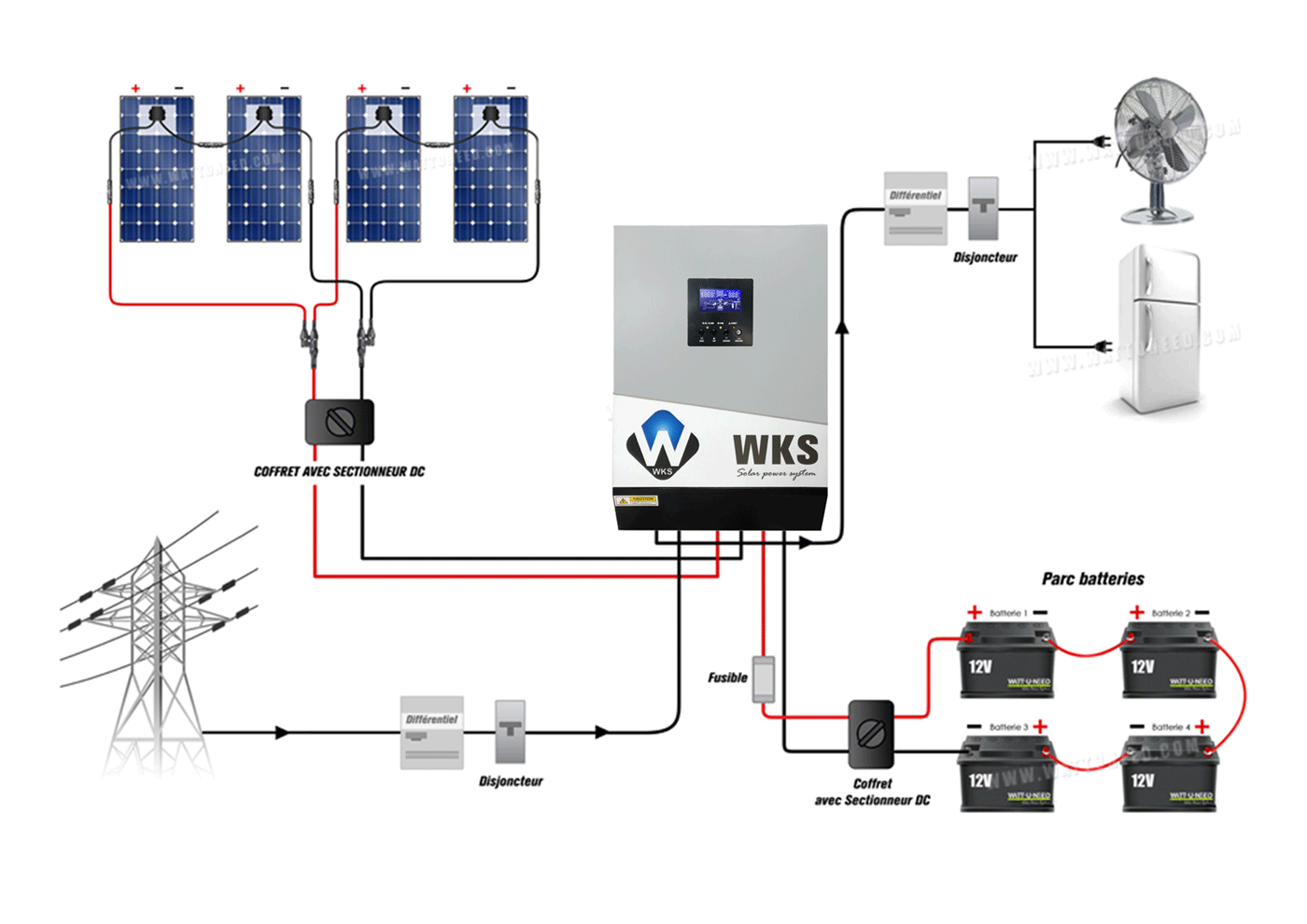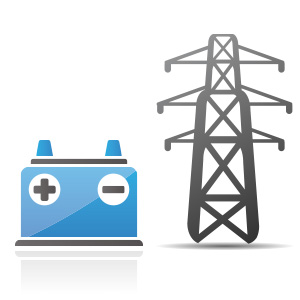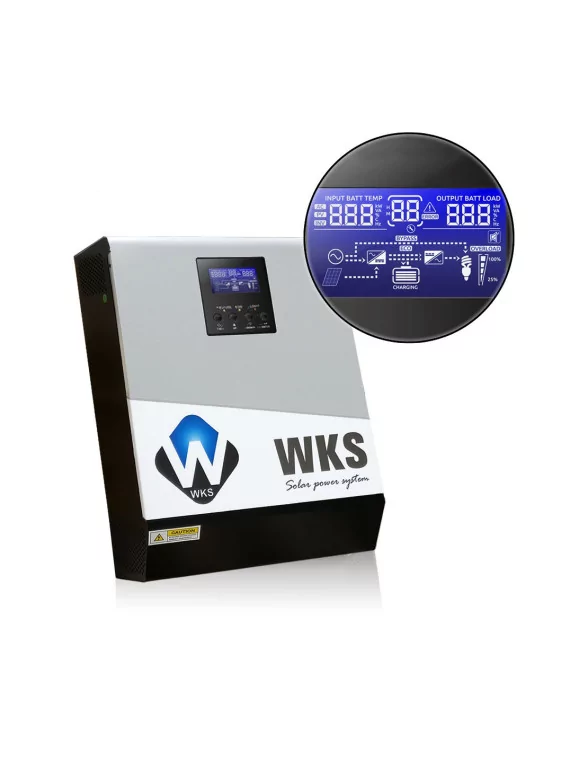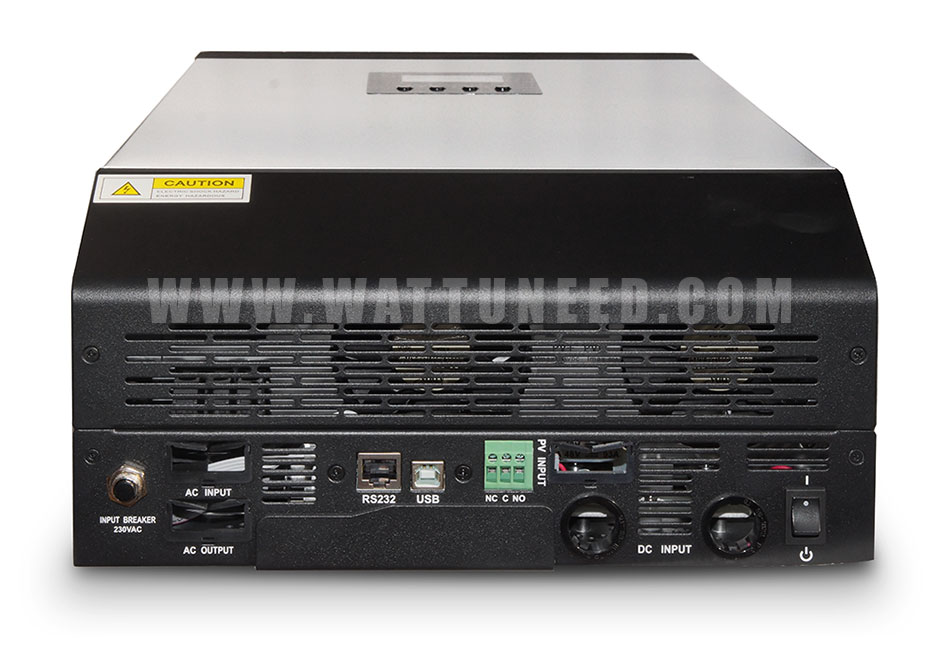The new-generation inverter
Benefit from continuous, reliable power, whether the grid is available or not. The energy produced by WKS inverters is directed and used intelligently for optimum performance. All priorities can be set by the user: use of batteries, solar or AC source (grid or generator). In self-consumption, the energy produced by your panels fluctuates and does not correspond to consumption. The WKS inverter stores part of the solar output in the batteries for later use during the evening or night. On isolated sites, the WKS inverter can be connected to a generator to charge the batteries if they are empty and solar output is insufficient. This inverter is capable of working with several different energy sources, such as :
- public grid
- photovoltaic panels
- thermal generator
- batteries
Microprocessor-based management directs energy according to production, consumption requirements and battery state-of-charge. Real-time monitoring can be carried out locally or remotely. The WKS inverter does not feed power back into the grid.

3 operating modes
- Solar priority
- Backup
- Solar and grid
- Battery charging current adjustment
- Possibility of limiting or prohibiting charging via the network
- Input voltage from 90 to 280V (useful for fluctuating networks)
- Economy mode (self-consumption limitation)
- Fine-tuning of battery charging characteristics
- Automatic restart in the event of overload or overtemperature
- Possibility of limiting battery discharge to preserve battery life
- Configurable return voltage to battery mode
- Overload bypass (to switch to mains supply in the event of peak consumption)
- Low battery protection
- USB port
Multi-power supply
Example: for a consumption requirement of 1kW, you could have a configuration:
- 0.5 kW supplied by solar power 0
- .5 kW supplied by batteries
This multi-supply technique greatly reduces the number of batteries required, and extends their lifespan.
This inverter accepts up to 750 Wp of photovoltaic panels, and can be connected to the grid or to another renewable energy source if solar production is insufficient.
Applications :
- Residential, commercial and telecommunications
- Areas with unstable electricity supplies
- Areas not connected to the grid
Use in back-up mode
The inverter can be used as a "back-up" without photovoltaic panels. In this mode, the inverter acts as a UPS, protecting your appliances from grid outages.
The UPS protects computers and audio-visual equipment, or any other sensitive load, by supplying a stable current. It guarantees uninterrupted power supply to consumers.
The electricity produced by these pure sinusoidal inverters is stable.
You can protect one or more rooms in your home via the distribution box.

Off-grid operation
In this configuration, the inverter uses the panels to power consumers and charge batteries when the sun is shining. The inverter draws power from the batteries to ensure energy distribution at night.
A generator can be added to the inverter's AC input to provide emergency power.
Hybrid operation
The inverter takes power from the grid only if the batteries are empty and solar production was not sufficient to cover consumption.
The inverter does not feed power back into the grid.
As with the "back-up" mode, you can connect only part of your domestic installation to the inverter. Consumers connected to the inverter will still be powered, even in the event of a mains power cut. What's more, they'll be supplied free of charge!
The WKS 4.0 and 5.0 models (rated at 4 and 5 kVA respectively) can be connected in parallel, adding up to their power. You can connect up to 4 devices in parallel, for a total output of 20 kVA.

Pure Sinus converter
The WKS is a pure sinusoidal voltage inverter that reproduces a power quality similar to that of the public grid. It can be used to power all types of appliance.
MPPT controller
The WKS also features MPPT (Maximum Power Point Tracking) technology, i.e. it constantly searches for the maximum power point, enabling maximum performance from photovoltaic panels. As well as boosting the energy output of an installation, it optimizes battery charging and extends battery life. It scans the panel voltage to find the maximum power output point, and is able to adapt the voltage supplied by the panel to align it with the voltage the battery can receive.
Not compatible with remote display.
Specifications
| Voltage range | 90-140 or 170-280 VAC (> |
computer)
65-140 or 90-280 VAC (> residential) |
| AC voltage regulation (Batt. |
| Mode) | 110 / 120 VAC ±5 % or 230 VAC ±5 % |
| Peak power (5 sec) | 2000 VA |
| Transfer time | 10 ms (for computers) ; |
| 20 ms (for residential applications) |
| Nominal battery voltage | 24 VDC |
| Battery types | AGM, GEL, |
| open (configurable) |
| Floating voltage | 27 VDC (configurable) |
| Overcharge protection | 31 VDC |
| Maximum charging current | 20A |
| MPPT operating range | 30 ~ 66 VDC |
| Maximum PV open circuit voltage | 75 VDC |
| Max. charging current | 25 A |
| Standby power consumption |
| W |
| Dimension, |
| D x W x H (mm) | 100 x 272 x 355 |
-10°C
-15°C















![]()
![]()
